NSW Mental Health Services: Stakeholder Analysis and Use Case Model
VerifiedAdded on 2024/06/27
|10
|3434
|404
Case Study
AI Summary
This case study examines the "Headspace" mental health organization in NSW, focusing on its stakeholder analysis and use case modeling. The organization, aimed at helping young people aged 12-25 with mental health issues like anxiety and depression, relies on various stakeholders, including internal executives (directors, trustees, board members, hospital staff), internal operations (doctors, nurses, support staff, volunteers, donors), external executives (population health executives, innovative executives, chiefs of staff, community partners), and external operations (chief clinical officers, physician leadership roles, patients, suppliers). The study includes a stakeholder map and analysis, a questionnaire to gather information, and a use case model for the information system, detailing processes like patient registration, doctor's appointments, bed allotment, tests, operations, admissions/discharge, patient information management, staff information editing, and payment processing. The case study highlights the importance of mental health care and the role of such organizations in providing support and treatment to young individuals. Desklib offers additional resources for students.
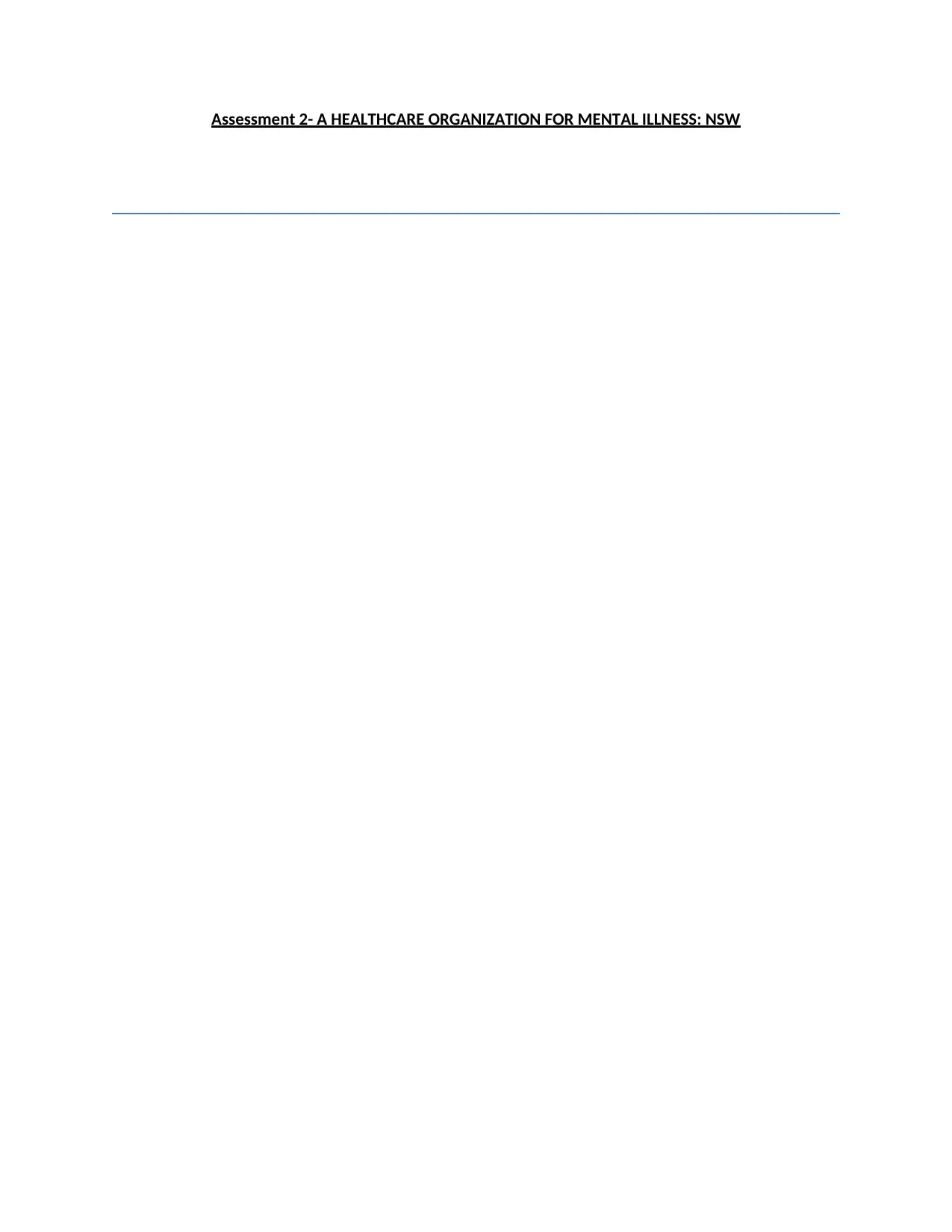
Assessment 2- A HEALTHCARE ORGANIZATION FOR MENTAL ILLNESS: NSW
Paraphrase This Document
Need a fresh take? Get an instant paraphrase of this document with our AI Paraphraser
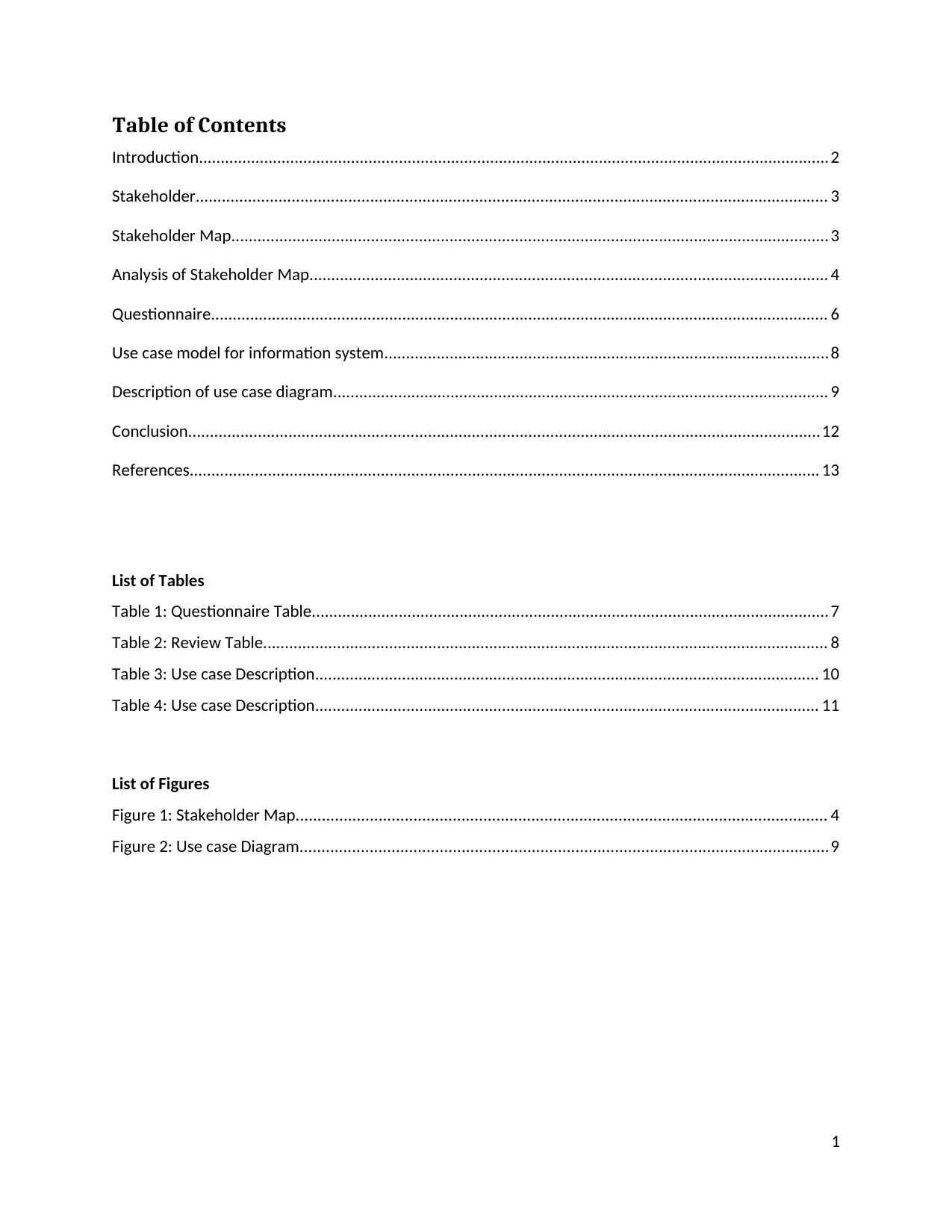
Table of Contents
Introduction.................................................................................................................................................2
Stakeholder................................................................................................................................................. 3
Stakeholder Map......................................................................................................................................... 3
Analysis of Stakeholder Map....................................................................................................................... 4
Questionnaire.............................................................................................................................................. 6
Use case model for information system......................................................................................................8
Description of use case diagram.................................................................................................................. 9
Conclusion.................................................................................................................................................12
References................................................................................................................................................. 13
List of Tables
Table 1: Questionnaire Table....................................................................................................................... 7
Table 2: Review Table.................................................................................................................................. 8
Table 3: Use case Description.................................................................................................................... 10
Table 4: Use case Description.................................................................................................................... 11
List of Figures
Figure 1: Stakeholder Map.......................................................................................................................... 4
Figure 2: Use case Diagram.........................................................................................................................9
1
Introduction.................................................................................................................................................2
Stakeholder................................................................................................................................................. 3
Stakeholder Map......................................................................................................................................... 3
Analysis of Stakeholder Map....................................................................................................................... 4
Questionnaire.............................................................................................................................................. 6
Use case model for information system......................................................................................................8
Description of use case diagram.................................................................................................................. 9
Conclusion.................................................................................................................................................12
References................................................................................................................................................. 13
List of Tables
Table 1: Questionnaire Table....................................................................................................................... 7
Table 2: Review Table.................................................................................................................................. 8
Table 3: Use case Description.................................................................................................................... 10
Table 4: Use case Description.................................................................................................................... 11
List of Figures
Figure 1: Stakeholder Map.......................................................................................................................... 4
Figure 2: Use case Diagram.........................................................................................................................9
1
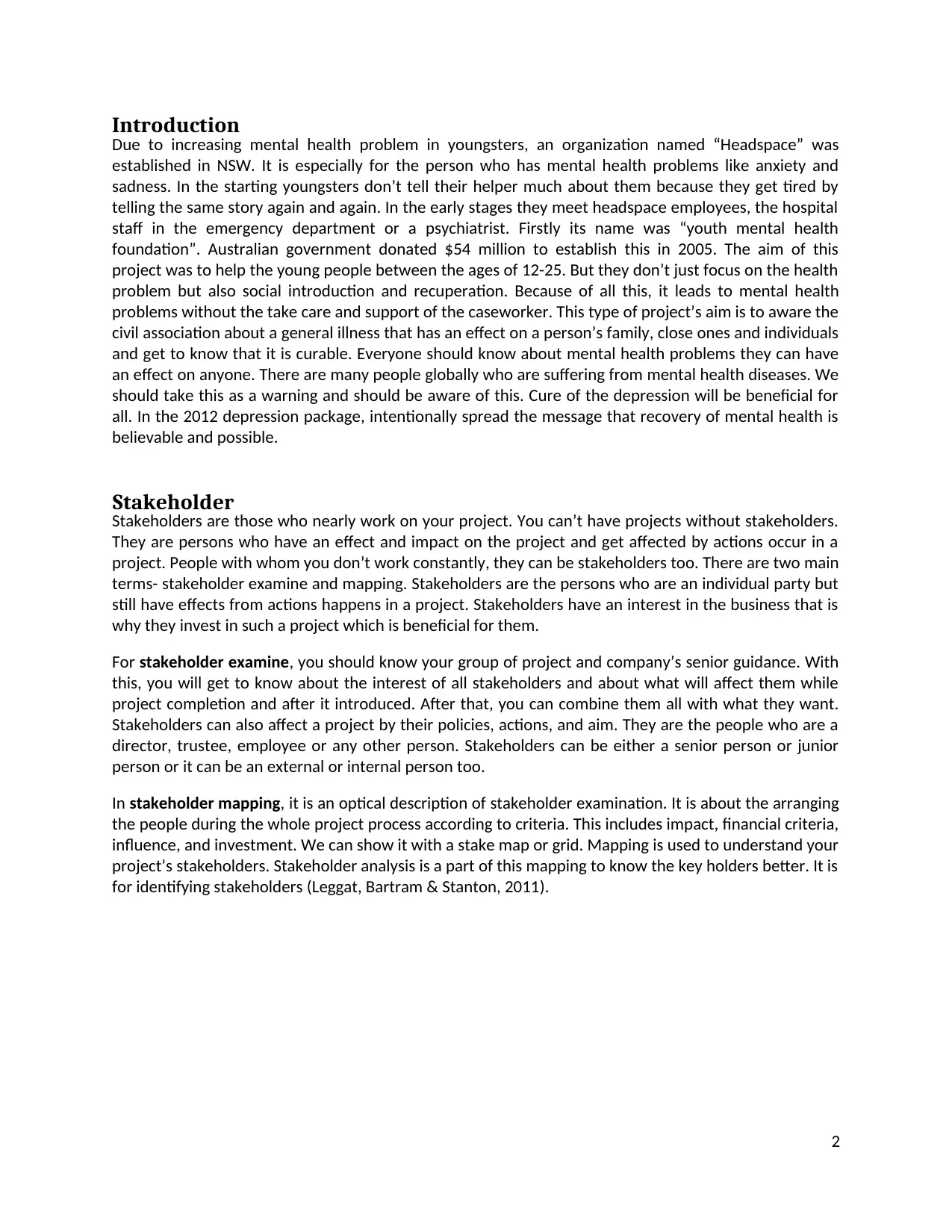
Introduction
Due to increasing mental health problem in youngsters, an organization named “Headspace” was
established in NSW. It is especially for the person who has mental health problems like anxiety and
sadness. In the starting youngsters don’t tell their helper much about them because they get tired by
telling the same story again and again. In the early stages they meet headspace employees, the hospital
staff in the emergency department or a psychiatrist. Firstly its name was “youth mental health
foundation”. Australian government donated $54 million to establish this in 2005. The aim of this
project was to help the young people between the ages of 12-25. But they don’t just focus on the health
problem but also social introduction and recuperation. Because of all this, it leads to mental health
problems without the take care and support of the caseworker. This type of project’s aim is to aware the
civil association about a general illness that has an effect on a person’s family, close ones and individuals
and get to know that it is curable. Everyone should know about mental health problems they can have
an effect on anyone. There are many people globally who are suffering from mental health diseases. We
should take this as a warning and should be aware of this. Cure of the depression will be beneficial for
all. In the 2012 depression package, intentionally spread the message that recovery of mental health is
believable and possible.
Stakeholder
Stakeholders are those who nearly work on your project. You can’t have projects without stakeholders.
They are persons who have an effect and impact on the project and get affected by actions occur in a
project. People with whom you don’t work constantly, they can be stakeholders too. There are two main
terms- stakeholder examine and mapping. Stakeholders are the persons who are an individual party but
still have effects from actions happens in a project. Stakeholders have an interest in the business that is
why they invest in such a project which is beneficial for them.
For stakeholder examine, you should know your group of project and company’s senior guidance. With
this, you will get to know about the interest of all stakeholders and about what will affect them while
project completion and after it introduced. After that, you can combine them all with what they want.
Stakeholders can also affect a project by their policies, actions, and aim. They are the people who are a
director, trustee, employee or any other person. Stakeholders can be either a senior person or junior
person or it can be an external or internal person too.
In stakeholder mapping, it is an optical description of stakeholder examination. It is about the arranging
the people during the whole project process according to criteria. This includes impact, financial criteria,
influence, and investment. We can show it with a stake map or grid. Mapping is used to understand your
project’s stakeholders. Stakeholder analysis is a part of this mapping to know the key holders better. It is
for identifying stakeholders (Leggat, Bartram & Stanton, 2011).
2
Due to increasing mental health problem in youngsters, an organization named “Headspace” was
established in NSW. It is especially for the person who has mental health problems like anxiety and
sadness. In the starting youngsters don’t tell their helper much about them because they get tired by
telling the same story again and again. In the early stages they meet headspace employees, the hospital
staff in the emergency department or a psychiatrist. Firstly its name was “youth mental health
foundation”. Australian government donated $54 million to establish this in 2005. The aim of this
project was to help the young people between the ages of 12-25. But they don’t just focus on the health
problem but also social introduction and recuperation. Because of all this, it leads to mental health
problems without the take care and support of the caseworker. This type of project’s aim is to aware the
civil association about a general illness that has an effect on a person’s family, close ones and individuals
and get to know that it is curable. Everyone should know about mental health problems they can have
an effect on anyone. There are many people globally who are suffering from mental health diseases. We
should take this as a warning and should be aware of this. Cure of the depression will be beneficial for
all. In the 2012 depression package, intentionally spread the message that recovery of mental health is
believable and possible.
Stakeholder
Stakeholders are those who nearly work on your project. You can’t have projects without stakeholders.
They are persons who have an effect and impact on the project and get affected by actions occur in a
project. People with whom you don’t work constantly, they can be stakeholders too. There are two main
terms- stakeholder examine and mapping. Stakeholders are the persons who are an individual party but
still have effects from actions happens in a project. Stakeholders have an interest in the business that is
why they invest in such a project which is beneficial for them.
For stakeholder examine, you should know your group of project and company’s senior guidance. With
this, you will get to know about the interest of all stakeholders and about what will affect them while
project completion and after it introduced. After that, you can combine them all with what they want.
Stakeholders can also affect a project by their policies, actions, and aim. They are the people who are a
director, trustee, employee or any other person. Stakeholders can be either a senior person or junior
person or it can be an external or internal person too.
In stakeholder mapping, it is an optical description of stakeholder examination. It is about the arranging
the people during the whole project process according to criteria. This includes impact, financial criteria,
influence, and investment. We can show it with a stake map or grid. Mapping is used to understand your
project’s stakeholders. Stakeholder analysis is a part of this mapping to know the key holders better. It is
for identifying stakeholders (Leggat, Bartram & Stanton, 2011).
2
⊘ This is a preview!⊘
Do you want full access?
Subscribe today to unlock all pages.

Trusted by 1+ million students worldwide
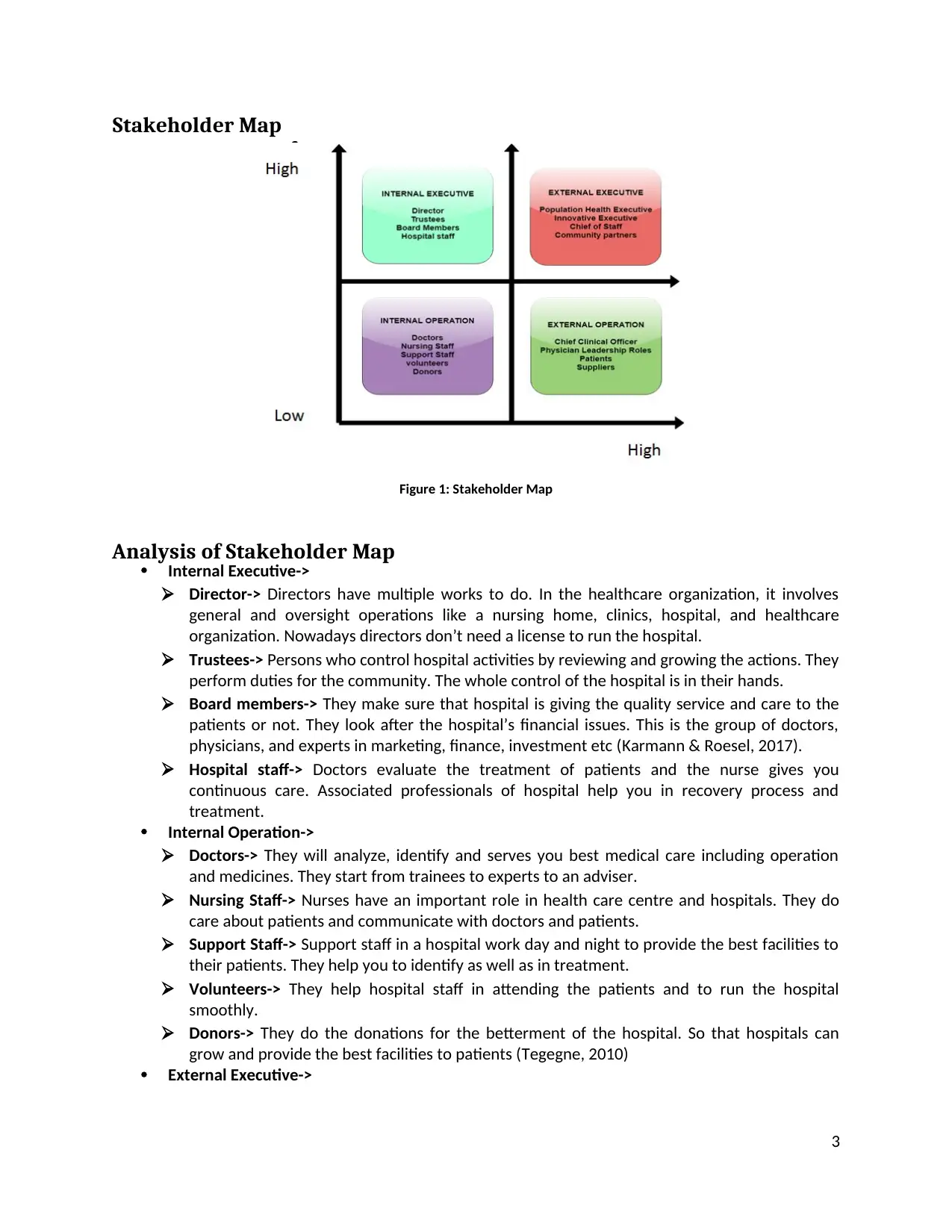
Stakeholder Map
Figure 1: Stakeholder Map
Analysis of Stakeholder Map
Internal Executive->
Director-> Directors have multiple works to do. In the healthcare organization, it involves
general and oversight operations like a nursing home, clinics, hospital, and healthcare
organization. Nowadays directors don’t need a license to run the hospital.
Trustees-> Persons who control hospital activities by reviewing and growing the actions. They
perform duties for the community. The whole control of the hospital is in their hands.
Board members-> They make sure that hospital is giving the quality service and care to the
patients or not. They look after the hospital’s financial issues. This is the group of doctors,
physicians, and experts in marketing, finance, investment etc (Karmann & Roesel, 2017).
Hospital staff-> Doctors evaluate the treatment of patients and the nurse gives you
continuous care. Associated professionals of hospital help you in recovery process and
treatment.
Internal Operation->
Doctors-> They will analyze, identify and serves you best medical care including operation
and medicines. They start from trainees to experts to an adviser.
Nursing Staff-> Nurses have an important role in health care centre and hospitals. They do
care about patients and communicate with doctors and patients.
Support Staff-> Support staff in a hospital work day and night to provide the best facilities to
their patients. They help you to identify as well as in treatment.
Volunteers-> They help hospital staff in attending the patients and to run the hospital
smoothly.
Donors-> They do the donations for the betterment of the hospital. So that hospitals can
grow and provide the best facilities to patients (Tegegne, 2010)
External Executive->
3
Figure 1: Stakeholder Map
Analysis of Stakeholder Map
Internal Executive->
Director-> Directors have multiple works to do. In the healthcare organization, it involves
general and oversight operations like a nursing home, clinics, hospital, and healthcare
organization. Nowadays directors don’t need a license to run the hospital.
Trustees-> Persons who control hospital activities by reviewing and growing the actions. They
perform duties for the community. The whole control of the hospital is in their hands.
Board members-> They make sure that hospital is giving the quality service and care to the
patients or not. They look after the hospital’s financial issues. This is the group of doctors,
physicians, and experts in marketing, finance, investment etc (Karmann & Roesel, 2017).
Hospital staff-> Doctors evaluate the treatment of patients and the nurse gives you
continuous care. Associated professionals of hospital help you in recovery process and
treatment.
Internal Operation->
Doctors-> They will analyze, identify and serves you best medical care including operation
and medicines. They start from trainees to experts to an adviser.
Nursing Staff-> Nurses have an important role in health care centre and hospitals. They do
care about patients and communicate with doctors and patients.
Support Staff-> Support staff in a hospital work day and night to provide the best facilities to
their patients. They help you to identify as well as in treatment.
Volunteers-> They help hospital staff in attending the patients and to run the hospital
smoothly.
Donors-> They do the donations for the betterment of the hospital. So that hospitals can
grow and provide the best facilities to patients (Tegegne, 2010)
External Executive->
3
Paraphrase This Document
Need a fresh take? Get an instant paraphrase of this document with our AI Paraphraser
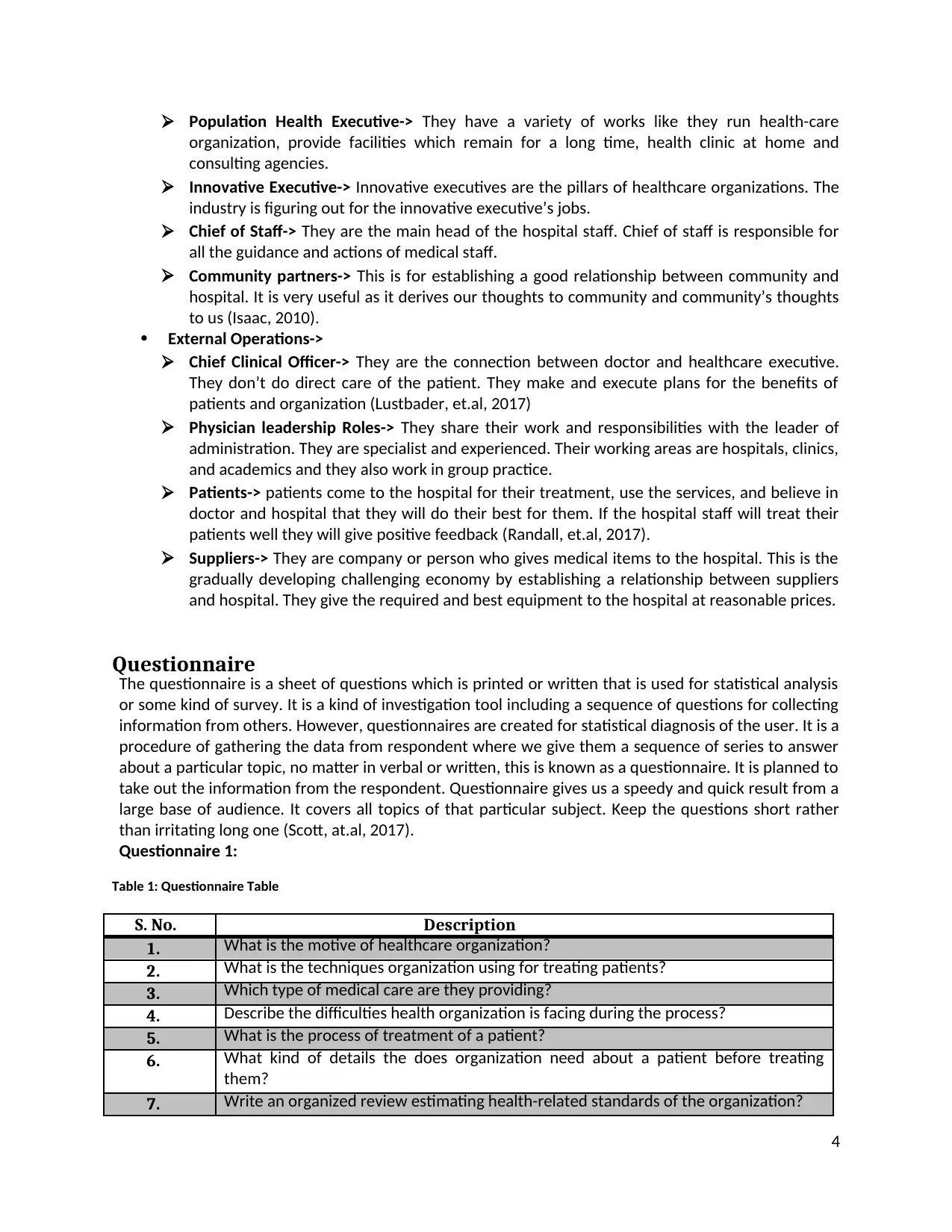
Population Health Executive-> They have a variety of works like they run health-care
organization, provide facilities which remain for a long time, health clinic at home and
consulting agencies.
Innovative Executive-> Innovative executives are the pillars of healthcare organizations. The
industry is figuring out for the innovative executive’s jobs.
Chief of Staff-> They are the main head of the hospital staff. Chief of staff is responsible for
all the guidance and actions of medical staff.
Community partners-> This is for establishing a good relationship between community and
hospital. It is very useful as it derives our thoughts to community and community’s thoughts
to us (Isaac, 2010).
External Operations->
Chief Clinical Officer-> They are the connection between doctor and healthcare executive.
They don’t do direct care of the patient. They make and execute plans for the benefits of
patients and organization (Lustbader, et.al, 2017)
Physician leadership Roles-> They share their work and responsibilities with the leader of
administration. They are specialist and experienced. Their working areas are hospitals, clinics,
and academics and they also work in group practice.
Patients-> patients come to the hospital for their treatment, use the services, and believe in
doctor and hospital that they will do their best for them. If the hospital staff will treat their
patients well they will give positive feedback (Randall, et.al, 2017).
Suppliers-> They are company or person who gives medical items to the hospital. This is the
gradually developing challenging economy by establishing a relationship between suppliers
and hospital. They give the required and best equipment to the hospital at reasonable prices.
Questionnaire
The questionnaire is a sheet of questions which is printed or written that is used for statistical analysis
or some kind of survey. It is a kind of investigation tool including a sequence of questions for collecting
information from others. However, questionnaires are created for statistical diagnosis of the user. It is a
procedure of gathering the data from respondent where we give them a sequence of series to answer
about a particular topic, no matter in verbal or written, this is known as a questionnaire. It is planned to
take out the information from the respondent. Questionnaire gives us a speedy and quick result from a
large base of audience. It covers all topics of that particular subject. Keep the questions short rather
than irritating long one (Scott, at.al, 2017).
Questionnaire 1:
Table 1: Questionnaire Table
S. No. Description
1. What is the motive of healthcare organization?
2. What is the techniques organization using for treating patients?
3. Which type of medical care are they providing?
4. Describe the difficulties health organization is facing during the process?
5. What is the process of treatment of a patient?
6. What kind of details the does organization need about a patient before treating
them?
7. Write an organized review estimating health-related standards of the organization?
4
organization, provide facilities which remain for a long time, health clinic at home and
consulting agencies.
Innovative Executive-> Innovative executives are the pillars of healthcare organizations. The
industry is figuring out for the innovative executive’s jobs.
Chief of Staff-> They are the main head of the hospital staff. Chief of staff is responsible for
all the guidance and actions of medical staff.
Community partners-> This is for establishing a good relationship between community and
hospital. It is very useful as it derives our thoughts to community and community’s thoughts
to us (Isaac, 2010).
External Operations->
Chief Clinical Officer-> They are the connection between doctor and healthcare executive.
They don’t do direct care of the patient. They make and execute plans for the benefits of
patients and organization (Lustbader, et.al, 2017)
Physician leadership Roles-> They share their work and responsibilities with the leader of
administration. They are specialist and experienced. Their working areas are hospitals, clinics,
and academics and they also work in group practice.
Patients-> patients come to the hospital for their treatment, use the services, and believe in
doctor and hospital that they will do their best for them. If the hospital staff will treat their
patients well they will give positive feedback (Randall, et.al, 2017).
Suppliers-> They are company or person who gives medical items to the hospital. This is the
gradually developing challenging economy by establishing a relationship between suppliers
and hospital. They give the required and best equipment to the hospital at reasonable prices.
Questionnaire
The questionnaire is a sheet of questions which is printed or written that is used for statistical analysis
or some kind of survey. It is a kind of investigation tool including a sequence of questions for collecting
information from others. However, questionnaires are created for statistical diagnosis of the user. It is a
procedure of gathering the data from respondent where we give them a sequence of series to answer
about a particular topic, no matter in verbal or written, this is known as a questionnaire. It is planned to
take out the information from the respondent. Questionnaire gives us a speedy and quick result from a
large base of audience. It covers all topics of that particular subject. Keep the questions short rather
than irritating long one (Scott, at.al, 2017).
Questionnaire 1:
Table 1: Questionnaire Table
S. No. Description
1. What is the motive of healthcare organization?
2. What is the techniques organization using for treating patients?
3. Which type of medical care are they providing?
4. Describe the difficulties health organization is facing during the process?
5. What is the process of treatment of a patient?
6. What kind of details the does organization need about a patient before treating
them?
7. Write an organized review estimating health-related standards of the organization?
4
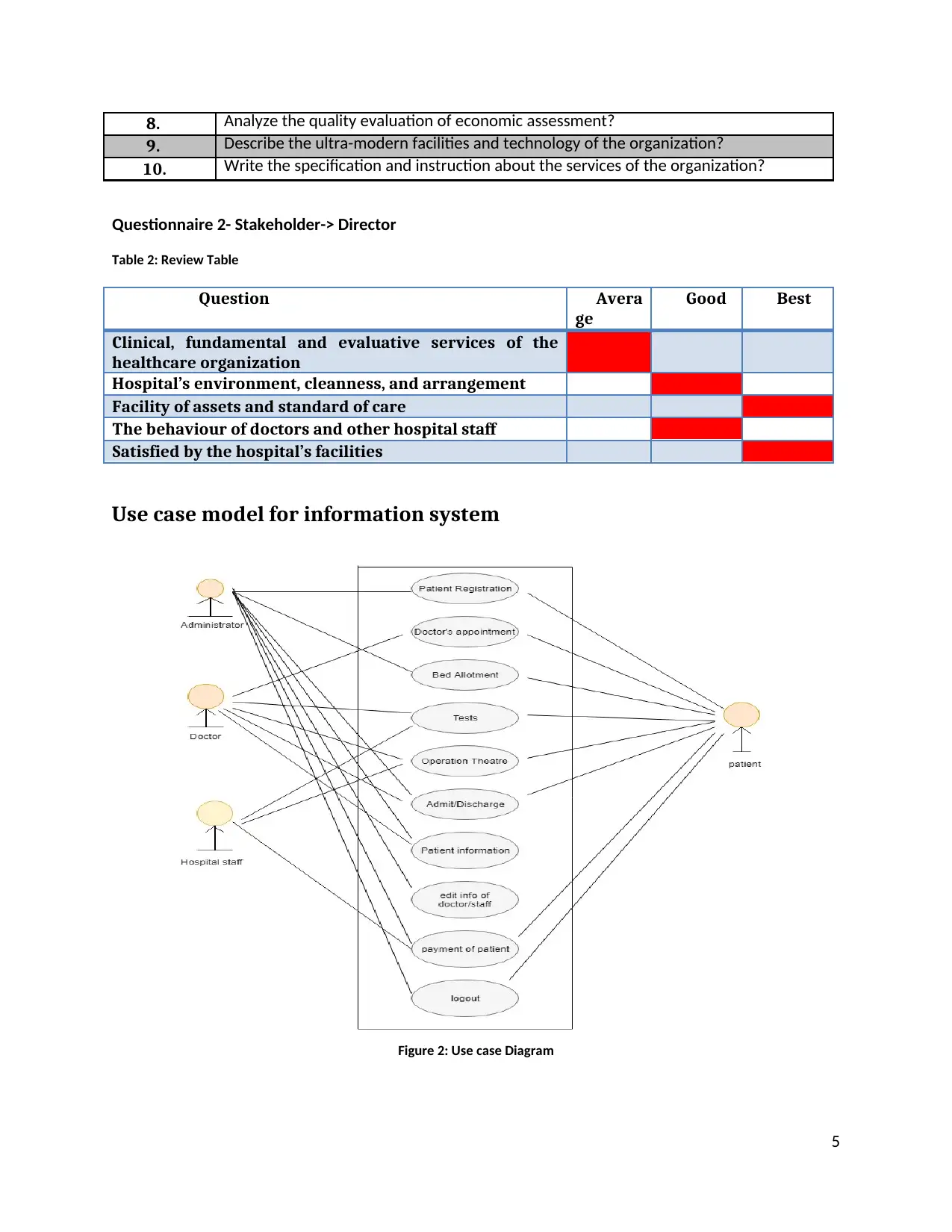
8. Analyze the quality evaluation of economic assessment?
9. Describe the ultra-modern facilities and technology of the organization?
10. Write the specification and instruction about the services of the organization?
Questionnaire 2- Stakeholder-> Director
Table 2: Review Table
Question Avera
ge
Good Best
Clinical, fundamental and evaluative services of the
healthcare organization
Hospital’s environment, cleanness, and arrangement
Facility of assets and standard of care
The behaviour of doctors and other hospital staff
Satisfied by the hospital’s facilities
Use case model for information system
Figure 2: Use case Diagram
5
9. Describe the ultra-modern facilities and technology of the organization?
10. Write the specification and instruction about the services of the organization?
Questionnaire 2- Stakeholder-> Director
Table 2: Review Table
Question Avera
ge
Good Best
Clinical, fundamental and evaluative services of the
healthcare organization
Hospital’s environment, cleanness, and arrangement
Facility of assets and standard of care
The behaviour of doctors and other hospital staff
Satisfied by the hospital’s facilities
Use case model for information system
Figure 2: Use case Diagram
5
⊘ This is a preview!⊘
Do you want full access?
Subscribe today to unlock all pages.

Trusted by 1+ million students worldwide
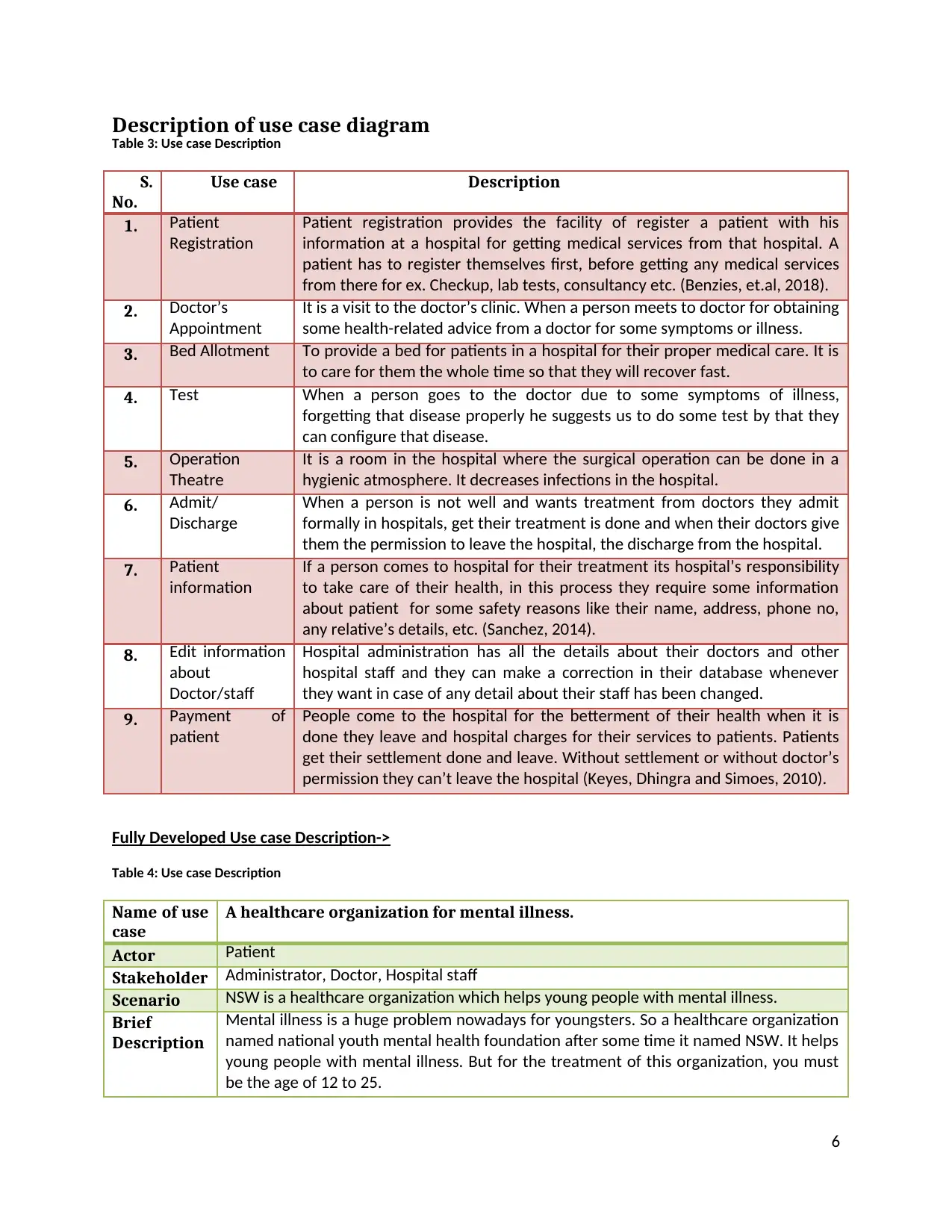
Description of use case diagram
Table 3: Use case Description
S.
No.
Use case Description
1. Patient
Registration
Patient registration provides the facility of register a patient with his
information at a hospital for getting medical services from that hospital. A
patient has to register themselves first, before getting any medical services
from there for ex. Checkup, lab tests, consultancy etc. (Benzies, et.al, 2018).
2. Doctor’s
Appointment
It is a visit to the doctor’s clinic. When a person meets to doctor for obtaining
some health-related advice from a doctor for some symptoms or illness.
3. Bed Allotment To provide a bed for patients in a hospital for their proper medical care. It is
to care for them the whole time so that they will recover fast.
4. Test When a person goes to the doctor due to some symptoms of illness,
forgetting that disease properly he suggests us to do some test by that they
can configure that disease.
5. Operation
Theatre
It is a room in the hospital where the surgical operation can be done in a
hygienic atmosphere. It decreases infections in the hospital.
6. Admit/
Discharge
When a person is not well and wants treatment from doctors they admit
formally in hospitals, get their treatment is done and when their doctors give
them the permission to leave the hospital, the discharge from the hospital.
7. Patient
information
If a person comes to hospital for their treatment its hospital’s responsibility
to take care of their health, in this process they require some information
about patient for some safety reasons like their name, address, phone no,
any relative’s details, etc. (Sanchez, 2014).
8. Edit information
about
Doctor/staff
Hospital administration has all the details about their doctors and other
hospital staff and they can make a correction in their database whenever
they want in case of any detail about their staff has been changed.
9. Payment of
patient
People come to the hospital for the betterment of their health when it is
done they leave and hospital charges for their services to patients. Patients
get their settlement done and leave. Without settlement or without doctor’s
permission they can’t leave the hospital (Keyes, Dhingra and Simoes, 2010).
Fully Developed Use case Description->
Table 4: Use case Description
Name of use
case
A healthcare organization for mental illness.
Actor Patient
Stakeholder Administrator, Doctor, Hospital staff
Scenario NSW is a healthcare organization which helps young people with mental illness.
Brief
Description
Mental illness is a huge problem nowadays for youngsters. So a healthcare organization
named national youth mental health foundation after some time it named NSW. It helps
young people with mental illness. But for the treatment of this organization, you must
be the age of 12 to 25.
6
Table 3: Use case Description
S.
No.
Use case Description
1. Patient
Registration
Patient registration provides the facility of register a patient with his
information at a hospital for getting medical services from that hospital. A
patient has to register themselves first, before getting any medical services
from there for ex. Checkup, lab tests, consultancy etc. (Benzies, et.al, 2018).
2. Doctor’s
Appointment
It is a visit to the doctor’s clinic. When a person meets to doctor for obtaining
some health-related advice from a doctor for some symptoms or illness.
3. Bed Allotment To provide a bed for patients in a hospital for their proper medical care. It is
to care for them the whole time so that they will recover fast.
4. Test When a person goes to the doctor due to some symptoms of illness,
forgetting that disease properly he suggests us to do some test by that they
can configure that disease.
5. Operation
Theatre
It is a room in the hospital where the surgical operation can be done in a
hygienic atmosphere. It decreases infections in the hospital.
6. Admit/
Discharge
When a person is not well and wants treatment from doctors they admit
formally in hospitals, get their treatment is done and when their doctors give
them the permission to leave the hospital, the discharge from the hospital.
7. Patient
information
If a person comes to hospital for their treatment its hospital’s responsibility
to take care of their health, in this process they require some information
about patient for some safety reasons like their name, address, phone no,
any relative’s details, etc. (Sanchez, 2014).
8. Edit information
about
Doctor/staff
Hospital administration has all the details about their doctors and other
hospital staff and they can make a correction in their database whenever
they want in case of any detail about their staff has been changed.
9. Payment of
patient
People come to the hospital for the betterment of their health when it is
done they leave and hospital charges for their services to patients. Patients
get their settlement done and leave. Without settlement or without doctor’s
permission they can’t leave the hospital (Keyes, Dhingra and Simoes, 2010).
Fully Developed Use case Description->
Table 4: Use case Description
Name of use
case
A healthcare organization for mental illness.
Actor Patient
Stakeholder Administrator, Doctor, Hospital staff
Scenario NSW is a healthcare organization which helps young people with mental illness.
Brief
Description
Mental illness is a huge problem nowadays for youngsters. So a healthcare organization
named national youth mental health foundation after some time it named NSW. It helps
young people with mental illness. But for the treatment of this organization, you must
be the age of 12 to 25.
6
Paraphrase This Document
Need a fresh take? Get an instant paraphrase of this document with our AI Paraphraser
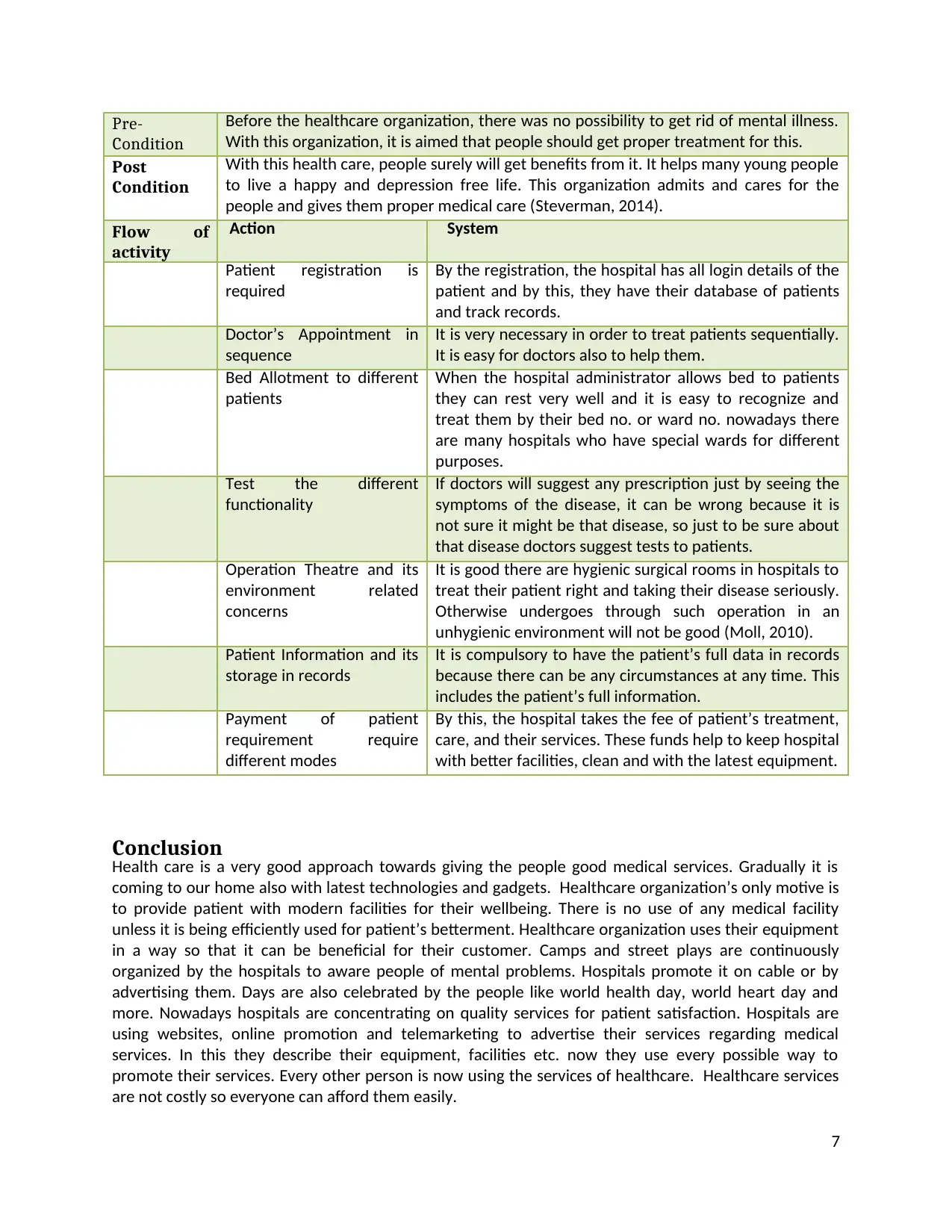
Pre-
Condition
Before the healthcare organization, there was no possibility to get rid of mental illness.
With this organization, it is aimed that people should get proper treatment for this.
Post
Condition
With this health care, people surely will get benefits from it. It helps many young people
to live a happy and depression free life. This organization admits and cares for the
people and gives them proper medical care (Steverman, 2014).
Flow of
activity
Action System
Patient registration is
required
By the registration, the hospital has all login details of the
patient and by this, they have their database of patients
and track records.
Doctor’s Appointment in
sequence
It is very necessary in order to treat patients sequentially.
It is easy for doctors also to help them.
Bed Allotment to different
patients
When the hospital administrator allows bed to patients
they can rest very well and it is easy to recognize and
treat them by their bed no. or ward no. nowadays there
are many hospitals who have special wards for different
purposes.
Test the different
functionality
If doctors will suggest any prescription just by seeing the
symptoms of the disease, it can be wrong because it is
not sure it might be that disease, so just to be sure about
that disease doctors suggest tests to patients.
Operation Theatre and its
environment related
concerns
It is good there are hygienic surgical rooms in hospitals to
treat their patient right and taking their disease seriously.
Otherwise undergoes through such operation in an
unhygienic environment will not be good (Moll, 2010).
Patient Information and its
storage in records
It is compulsory to have the patient’s full data in records
because there can be any circumstances at any time. This
includes the patient’s full information.
Payment of patient
requirement require
different modes
By this, the hospital takes the fee of patient’s treatment,
care, and their services. These funds help to keep hospital
with better facilities, clean and with the latest equipment.
Conclusion
Health care is a very good approach towards giving the people good medical services. Gradually it is
coming to our home also with latest technologies and gadgets. Healthcare organization’s only motive is
to provide patient with modern facilities for their wellbeing. There is no use of any medical facility
unless it is being efficiently used for patient’s betterment. Healthcare organization uses their equipment
in a way so that it can be beneficial for their customer. Camps and street plays are continuously
organized by the hospitals to aware people of mental problems. Hospitals promote it on cable or by
advertising them. Days are also celebrated by the people like world health day, world heart day and
more. Nowadays hospitals are concentrating on quality services for patient satisfaction. Hospitals are
using websites, online promotion and telemarketing to advertise their services regarding medical
services. In this they describe their equipment, facilities etc. now they use every possible way to
promote their services. Every other person is now using the services of healthcare. Healthcare services
are not costly so everyone can afford them easily.
7
Condition
Before the healthcare organization, there was no possibility to get rid of mental illness.
With this organization, it is aimed that people should get proper treatment for this.
Post
Condition
With this health care, people surely will get benefits from it. It helps many young people
to live a happy and depression free life. This organization admits and cares for the
people and gives them proper medical care (Steverman, 2014).
Flow of
activity
Action System
Patient registration is
required
By the registration, the hospital has all login details of the
patient and by this, they have their database of patients
and track records.
Doctor’s Appointment in
sequence
It is very necessary in order to treat patients sequentially.
It is easy for doctors also to help them.
Bed Allotment to different
patients
When the hospital administrator allows bed to patients
they can rest very well and it is easy to recognize and
treat them by their bed no. or ward no. nowadays there
are many hospitals who have special wards for different
purposes.
Test the different
functionality
If doctors will suggest any prescription just by seeing the
symptoms of the disease, it can be wrong because it is
not sure it might be that disease, so just to be sure about
that disease doctors suggest tests to patients.
Operation Theatre and its
environment related
concerns
It is good there are hygienic surgical rooms in hospitals to
treat their patient right and taking their disease seriously.
Otherwise undergoes through such operation in an
unhygienic environment will not be good (Moll, 2010).
Patient Information and its
storage in records
It is compulsory to have the patient’s full data in records
because there can be any circumstances at any time. This
includes the patient’s full information.
Payment of patient
requirement require
different modes
By this, the hospital takes the fee of patient’s treatment,
care, and their services. These funds help to keep hospital
with better facilities, clean and with the latest equipment.
Conclusion
Health care is a very good approach towards giving the people good medical services. Gradually it is
coming to our home also with latest technologies and gadgets. Healthcare organization’s only motive is
to provide patient with modern facilities for their wellbeing. There is no use of any medical facility
unless it is being efficiently used for patient’s betterment. Healthcare organization uses their equipment
in a way so that it can be beneficial for their customer. Camps and street plays are continuously
organized by the hospitals to aware people of mental problems. Hospitals promote it on cable or by
advertising them. Days are also celebrated by the people like world health day, world heart day and
more. Nowadays hospitals are concentrating on quality services for patient satisfaction. Hospitals are
using websites, online promotion and telemarketing to advertise their services regarding medical
services. In this they describe their equipment, facilities etc. now they use every possible way to
promote their services. Every other person is now using the services of healthcare. Healthcare services
are not costly so everyone can afford them easily.
7
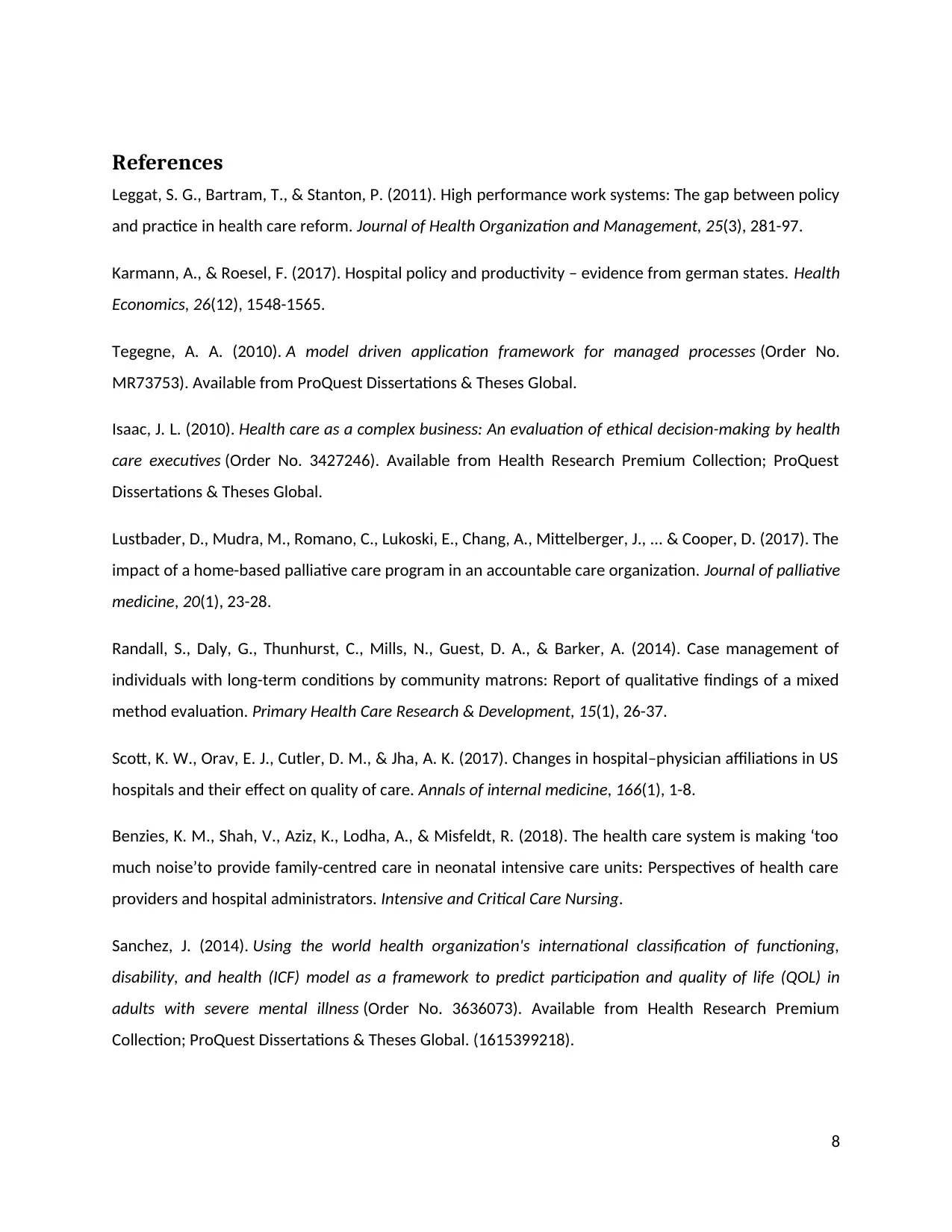
References
Leggat, S. G., Bartram, T., & Stanton, P. (2011). High performance work systems: The gap between policy
and practice in health care reform. Journal of Health Organization and Management, 25(3), 281-97.
Karmann, A., & Roesel, F. (2017). Hospital policy and productivity – evidence from german states. Health
Economics, 26(12), 1548-1565.
Tegegne, A. A. (2010). A model driven application framework for managed processes (Order No.
MR73753). Available from ProQuest Dissertations & Theses Global.
Isaac, J. L. (2010). Health care as a complex business: An evaluation of ethical decision-making by health
care executives (Order No. 3427246). Available from Health Research Premium Collection; ProQuest
Dissertations & Theses Global.
Lustbader, D., Mudra, M., Romano, C., Lukoski, E., Chang, A., Mittelberger, J., ... & Cooper, D. (2017). The
impact of a home-based palliative care program in an accountable care organization. Journal of palliative
medicine, 20(1), 23-28.
Randall, S., Daly, G., Thunhurst, C., Mills, N., Guest, D. A., & Barker, A. (2014). Case management of
individuals with long-term conditions by community matrons: Report of qualitative findings of a mixed
method evaluation. Primary Health Care Research & Development, 15(1), 26-37.
Scott, K. W., Orav, E. J., Cutler, D. M., & Jha, A. K. (2017). Changes in hospital–physician affiliations in US
hospitals and their effect on quality of care. Annals of internal medicine, 166(1), 1-8.
Benzies, K. M., Shah, V., Aziz, K., Lodha, A., & Misfeldt, R. (2018). The health care system is making ‘too
much noise’to provide family-centred care in neonatal intensive care units: Perspectives of health care
providers and hospital administrators. Intensive and Critical Care Nursing.
Sanchez, J. (2014). Using the world health organization's international classification of functioning,
disability, and health (ICF) model as a framework to predict participation and quality of life (QOL) in
adults with severe mental illness (Order No. 3636073). Available from Health Research Premium
Collection; ProQuest Dissertations & Theses Global. (1615399218).
8
Leggat, S. G., Bartram, T., & Stanton, P. (2011). High performance work systems: The gap between policy
and practice in health care reform. Journal of Health Organization and Management, 25(3), 281-97.
Karmann, A., & Roesel, F. (2017). Hospital policy and productivity – evidence from german states. Health
Economics, 26(12), 1548-1565.
Tegegne, A. A. (2010). A model driven application framework for managed processes (Order No.
MR73753). Available from ProQuest Dissertations & Theses Global.
Isaac, J. L. (2010). Health care as a complex business: An evaluation of ethical decision-making by health
care executives (Order No. 3427246). Available from Health Research Premium Collection; ProQuest
Dissertations & Theses Global.
Lustbader, D., Mudra, M., Romano, C., Lukoski, E., Chang, A., Mittelberger, J., ... & Cooper, D. (2017). The
impact of a home-based palliative care program in an accountable care organization. Journal of palliative
medicine, 20(1), 23-28.
Randall, S., Daly, G., Thunhurst, C., Mills, N., Guest, D. A., & Barker, A. (2014). Case management of
individuals with long-term conditions by community matrons: Report of qualitative findings of a mixed
method evaluation. Primary Health Care Research & Development, 15(1), 26-37.
Scott, K. W., Orav, E. J., Cutler, D. M., & Jha, A. K. (2017). Changes in hospital–physician affiliations in US
hospitals and their effect on quality of care. Annals of internal medicine, 166(1), 1-8.
Benzies, K. M., Shah, V., Aziz, K., Lodha, A., & Misfeldt, R. (2018). The health care system is making ‘too
much noise’to provide family-centred care in neonatal intensive care units: Perspectives of health care
providers and hospital administrators. Intensive and Critical Care Nursing.
Sanchez, J. (2014). Using the world health organization's international classification of functioning,
disability, and health (ICF) model as a framework to predict participation and quality of life (QOL) in
adults with severe mental illness (Order No. 3636073). Available from Health Research Premium
Collection; ProQuest Dissertations & Theses Global. (1615399218).
8
⊘ This is a preview!⊘
Do you want full access?
Subscribe today to unlock all pages.

Trusted by 1+ million students worldwide
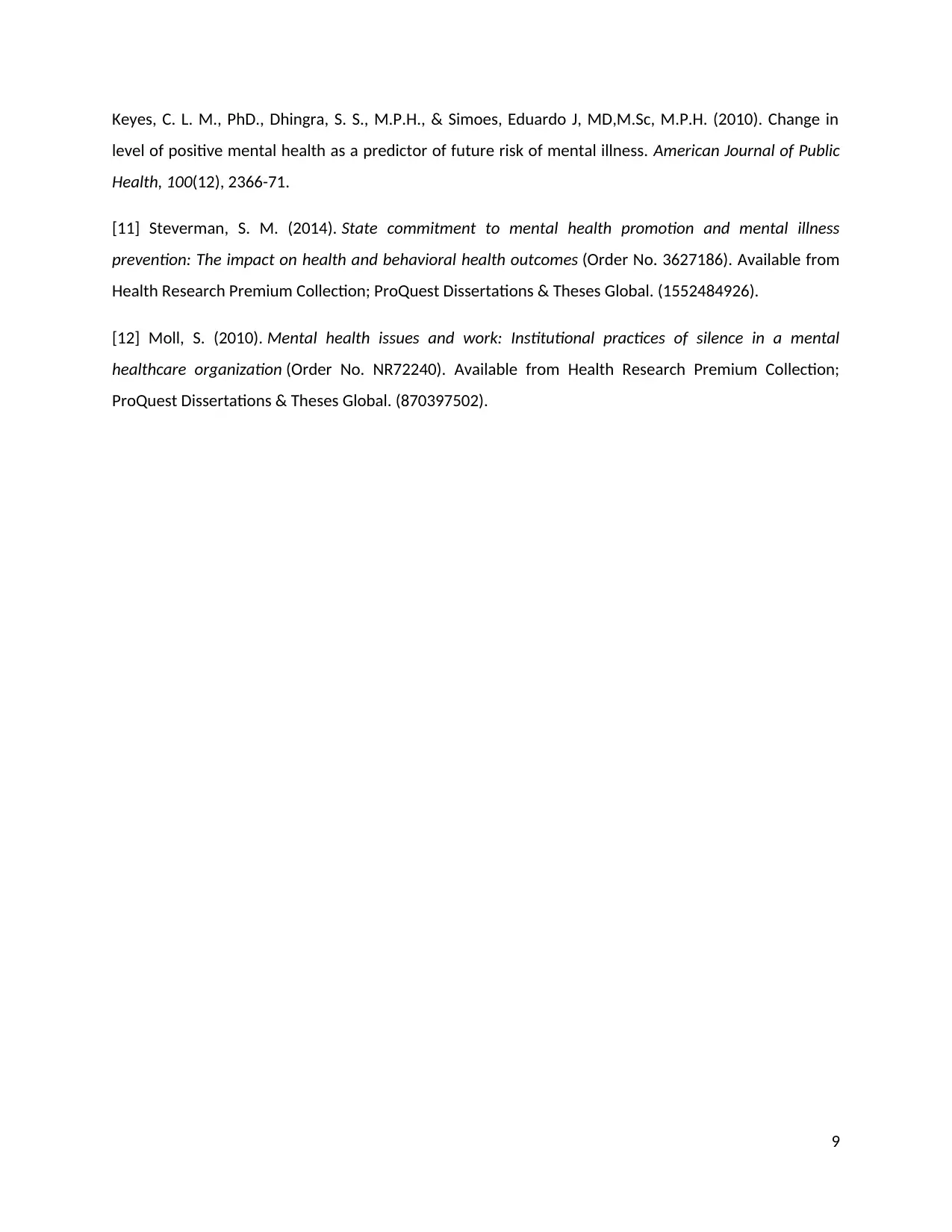
Keyes, C. L. M., PhD., Dhingra, S. S., M.P.H., & Simoes, Eduardo J, MD,M.Sc, M.P.H. (2010). Change in
level of positive mental health as a predictor of future risk of mental illness. American Journal of Public
Health, 100(12), 2366-71.
[11] Steverman, S. M. (2014). State commitment to mental health promotion and mental illness
prevention: The impact on health and behavioral health outcomes (Order No. 3627186). Available from
Health Research Premium Collection; ProQuest Dissertations & Theses Global. (1552484926).
[12] Moll, S. (2010). Mental health issues and work: Institutional practices of silence in a mental
healthcare organization (Order No. NR72240). Available from Health Research Premium Collection;
ProQuest Dissertations & Theses Global. (870397502).
9
level of positive mental health as a predictor of future risk of mental illness. American Journal of Public
Health, 100(12), 2366-71.
[11] Steverman, S. M. (2014). State commitment to mental health promotion and mental illness
prevention: The impact on health and behavioral health outcomes (Order No. 3627186). Available from
Health Research Premium Collection; ProQuest Dissertations & Theses Global. (1552484926).
[12] Moll, S. (2010). Mental health issues and work: Institutional practices of silence in a mental
healthcare organization (Order No. NR72240). Available from Health Research Premium Collection;
ProQuest Dissertations & Theses Global. (870397502).
9
1 out of 10
Related Documents
Your All-in-One AI-Powered Toolkit for Academic Success.
+13062052269
info@desklib.com
Available 24*7 on WhatsApp / Email
![[object Object]](/_next/static/media/star-bottom.7253800d.svg)
Unlock your academic potential
Copyright © 2020–2025 A2Z Services. All Rights Reserved. Developed and managed by ZUCOL.





